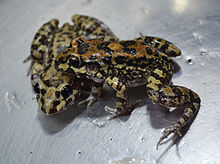Leptodactylus troglodytes
| Leptodactylus troglodytes | |
|---|---|

| |
| Scientific classification | |
| Domain: | Eukaryota |
| Kingdom: | Animalia |
| Phylum: | Chordata |
| Class: | Amphibia |
| Order: | Anura |
| Family: | Leptodactylidae |
| Genus: | Leptodactylus |
| Species: | L. troglodytes
|
| Binomial name | |
| Leptodactylus troglodytes Lutz, 1926
| |
Leptodactylus troglodytes (common names: Pernambuco white-lipped frog,[2] hole-dwelling thin-toed frog[3]) is a species of frog in the Leptodactylidae family. It is endemic to northeastern Brazil and occurs from northern Minas Gerais and Bahia to Maranhão, Piauí, Ceará, and Rio Grande do Norte.[1][2] The specific name, troglodytes, refers to its habit of breeding in underground chambers.
Reproduction
This species builds foam nests in underground chambers near water.[1][3] Single tunnel may have multiple chambers. Males are territorial and emit territorial as well as courtship calls, to which the female may reciprocate.[3]
Habitat and conservation
Leptodactylus troglodytes is a common species that occurs in dry and moist savanna and agricultural land in the Cerrado and Caatinga ecosystems and in dune systems in Atlantic Rainforest zone. It is impacted by intensive agriculture, overgrazing by livestock, and fire, but is not considered threatened as species.[1]
References
- ^ a b c d "Leptodactylus troglodytes". IUCN Red List of Threatened Species. 2010. IUCN: e.T57171A11595328. 2010. Retrieved 22 February 2016.
{{cite journal}}: Unknown parameter|authors=ignored (help) - ^ a b Frost, Darrel R. (2016). "Leptodactylus troglodytes Lutz, 1926". Amphibian Species of the World: an Online Reference. Version 6.0. American Museum of Natural History. Retrieved 22 February 2016.
- ^ a b c "Reproductive biology of the Brazilian sibilator frog Leptodactylus troglodytes". Herpetological Journal. 19 (3): 119–126. 2009.
{{cite journal}}: Unknown parameter|authors=ignored (help)

